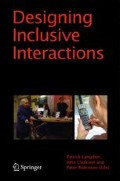Abstract
Widespread population ageing (Keates and Clarkson, 2004) has increased the importance of considering older and disabled people in the design process and reducing their exclusion from product usage. Accordingly, approaches such as ‘inclusive design’, ‘universal design’ and ‘design for all’ have been developed to help designers to include different user groups in design. Inclusive design research understands users’ abilities, needs and expectations, strives to relate the whole range of users’ capabilities to the properties of product interfaces, and aims to optimise design for maximum accessibility and minimise the effort required in using products. Currently, companies start to adopt a more inclusive approach to design led by a twofold moral and financial incentive. Previous research has shown that designers can provide good interaction in products by paying more attention to mental models of users, prior tacit knowledge, interface metaphors, affordances and mappings (Krippendorff, 1989; Norman, 2002). It is believed that inclusive interaction in products can be achieved by means of minimising the sensory, cognitive and motor effort required for product usage, facilitating simplicity and intuitiveness, providing perceptible information and enhancing user satisfaction (Langdon et al., 2010). To support designers in designing more inclusively, tools that foster understanding of sensory, motor and cognitive difficulty with product interactions are required. While the most valid technique will always be to have users interact with the product in question, a variety of constraints mean that this will not always be possible.
Access this chapter
Tax calculation will be finalised at checkout
Purchases are for personal use only
Preview
Unable to display preview. Download preview PDF.
References
Baddeley AD (2000) The episodic buffer: a new component of working memory? Trends in Cognitive Sciences, 4: 417–423
Blackler A (2006) Intuitive interaction with complex artefacts. PhD Thesis, School of Design, Queensland University of Technology, Australia
Cardoso C, Keates S, Clarkson PJ (2004) Comparing product assessment methods for inclusive design. In: Keates S, Clarkson PJ, Langdon P, Robinson P (eds.) Designing a more inclusive world. Springer, London, UK
Docampo-Rama M (2001) Technology generations handling complex user interfaces. PhD Thesis, Eindhoven University of Technology, The Netherlands
Dong H (2005) Barriers to inclusive design in the UK. PhD Thesis, University of Cambridge, Cambridge, UK
Freudenthal A (1999) The design of home appliances for young and old consumers. PhD Thesis, Delft University Press, The Netherlands
Goodman-Deane J, Langdon P, Clarkson PJ (2010) Key influences on the user-centred design process. Journal of Engineering Design (in press)
Gorsuch RL (1999) Factor analysis, 2nd edn. Erlbaum, Hillsdale, NJ, US
Hurtienne J, Blessing L (2007) Metaphors as tools for intuitive interaction with technology. metaphorik.de, 12: 21–52
Keates S, Clarkson PJ (2004) Countering design exclusion: an introduction to inclusive design. Springer, London, UK
Krippendorff K (1989) On the essential contexts of artifacts or on the proposition that design is making sense (of things). Design Issues, 5: 9–39
Langdon PM, Lewis T, Clarkson PJ (2007) The effects of prior experience on the use of consumer products. Universal Access in the Information Society, Special Issue on Designing Accessible Technology, 6: 179–191
Langdon PM, Lewis T, Clarkson PJ (2010) Prior experience in the use of domestic product interfaces. Universal Access in the Information Society (in press)
Mieczakowski A, Langdon P, Clarkson PJ (2009) Specifying an inclusive model of productuser interaction. In: Proceedings of the 17th International Conference on Engineering Design (Iced’09), Stanford, CA, US
Miller GA (1956) The magical number seven, plus or minus two: some limits on our capacity for processing information. The Psychological Review, 63: 81–97
Monk A (1998) Cyclic interaction: a unitary approach to intention, action and the environment. Cognition, 68: 95–110
Norman DA (2002) The design of everyday things. Basic Books, London, UK
Persad U, Langdon P, Clarkson PJ (2007) Characterising user capabilities to support inclusive design evaluation. Universal Access in the Information Society, Special Issue on Designing Accessible Technology, 6: 119–135
Rabbitt P (1993) Does it all go together when it goes? The nineteenth Bartlett memorial lecture. The Quarterly Journal of Experimental Psychology, 46A: 385–434
Stanton N, Hedge A, Brookhuis K, Salas E, Hendrick H (2005) Handbook of human factors and ergonomics methods. CRC Press, Boca Raton, FL, US
Thomas DR (2006) A general inductive approach for analysing qualitative evaluation data. American Journal of Evaluation, 27: 237–246
Wickens CD, Hollands JG (2000) Engineering psychology and human performance, 3rd edn. Prentice Hall, Upper Saddle River, NJ, US
Author information
Authors and Affiliations
Editor information
Editors and Affiliations
Rights and permissions
Copyright information
© 2010 Springer-Verlag London Limited
About this paper
Cite this paper
Mieczakowski, A., Langdon, P., Clarkson, P. (2010). Investigating Designers’ Cognitive Representations for Inclusive Interaction Between Products and Users. In: Langdon, P., Clarkson, P., Robinson, P. (eds) Designing Inclusive Interactions. Springer, London. https://doi.org/10.1007/978-1-84996-166-0_13
Download citation
DOI: https://doi.org/10.1007/978-1-84996-166-0_13
Publisher Name: Springer, London
Print ISBN: 978-1-84996-165-3
Online ISBN: 978-1-84996-166-0
eBook Packages: EngineeringEngineering (R0)

